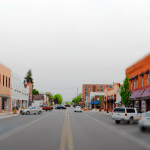A new Hardee’s just opened. That’s the buzz in our small town right now.
It’s not the kind of thing you’d put on a billboard in hopes to draw tourists, but it’s big news here. While the nearest large city (Raleigh) constantly advertises new restaurants—ones that boast of organic this-or-that and fresh, locally sourced ingredients—we celebrate new fast-food options.
That’s one way to sum up small-town life. Everything in a small town is slower and, well, smaller than in large cities. This makes small-town church planting a unique effort.
In seminary, I heard the call to plant churches in large cities. Tim Keller led the way in making our missional target the urban centers. And he’s right. Large cities desperately need churches.
Unfortunately, this call to cities has often been misunderstood as a call to abandon church planting in small towns. Keller rightly argues that we need more churches in cities because we’re not keeping up with population growth. But some wrongly assume, then, that rural areas must be in better shape. Actually, rural areas often lack clear gospel witness as well—and we mustn’t neglect that need in our urban push.
Prioritize the city centers and the small towns. We need gospel-centered church planting efforts in both contexts.
Prioritize the city centers and the small towns. We need gospel-centered church planting efforts in both contexts.
In 2009, my wife and I became burdened to plant a church in a small city—one surrounded by many smaller towns—in Eastern North Carolina. But everything I knew about church planting focused on models and methods for planting in large cities. We had to grapple with how to translate these methods to our context. And, like most other things in a small town, we moved slowly.
We launched Redeemer Church in September 2013. As we approach our fifth birthday, here are four (of many) lessons I’ve learned about church planting in small towns.
1. Move Slowly (Even When You Don’t Want To)
When traveling on one of the back roads in Rocky Mount, it’s not uncommon to get stuck behind farming equipment. Farmers use the local roads to get from one field to the next.
When I’m in a hurry, these moments present wonderful—even if unwelcome—opportunities for sanctification. I begin fantasizing about speeding around the combine or harvester that’s impeding my advance. But usually, waiting is the only option.
Moving farm equipment along country roads is painfully slow! And yet, people who have grown up here have learned to wait patiently for the equipment to arrive at its destination, at which point the road clears again.
Church planting is a marathon, not a sprint.
If I, a medium-sized-town migrant to a small town, were to speed out around the equipment, I’d be considered rude and clearly an outsider. Here’s what this simple experience is teaching me: things in small towns move slowly, and so should we. Church planting is a marathon, not a sprint.
Slow and steady is good, especially in small towns. We spent five years building relationships and credibility before we began vision-casting for what would become Redeemer Church. Any faster would’ve been too fast.
2. Plan to Stay (Even When the Going Gets Tough)
Large cities are transient. Small towns are not. When someone leaves a small town, and when someone new moves in, people notice.
In large cities, church plants often benefit from robust ministries to local universities. In small towns, a Bible study in a community college classroom (if the luxury of a community college exists) is a big win.
Without a large influx of college students and people moving into the area, growth is often slow. Don’t be discouraged; be committed. If you dedicate yourself to a people and a place, it will show.
Dedication is exemplified in both large and small actions. A small way to demonstrate your commitment is to frequent local businesses or serve local organizations. Often, these are at the heart of small-town identity. Additionally, identify some of the community’s needs that cannot be remedied with a “quick fix.” Be part of solutions that take time and effort (e.g., economic development; investing in local schools; meeting the needs of the overlooked, mistreated, and underprivileged).
Commitment breeds trust. The more committed you are to your community, the more likely natives will trust you. And trusting you is a good first step in them coming into contact with your new church.
3. Own the City’s Sin (Even When It’s Not Your Fault)
Here’s a false dichotomy: large places are infested with sin, but small towns are safe and sanitized.
Sin is present wherever sinners are present. Our small town is battling through racial division, rampant drug use, infidelity, violent crime, and more. When it comes to sin, the difference between big cities and small towns is one of scale, not severity. Sin is as serious in small towns as in big cities.
Sin is as serious in small towns as in big cities.
Once you’ve built credibility, you can begin to speak of the community’s sins as “our sins.” This is crucial. Rather than speaking as outsiders, we address the sins of our community as those committed to its redemption.
4. Speak of the Savior (Even When People Don’t Respond)
After all, isn’t this why you’re there? Cast a big gospel vision. Show how the gospel has power to transform whatever ills plague your small town.
Speak of a better and brighter future because of what Jesus will do in and through his church. You can’t do this until people believe you are for them and the community.
Jesus Christ is every small town’s greatest need.
This, of course, requires you to actually love your small town. But even when you fail to do so, remember that you have a Savior who never fails. He is every small town’s greatest need.
Church planting in small towns is anything but glamorous. But that’s okay. Jesus didn’t come for shiny, polished small towns; he came for needy, sinful ones.
Related:
- The Left Behind of Rural America (Stephen Witmer and Collin Hansen)




































